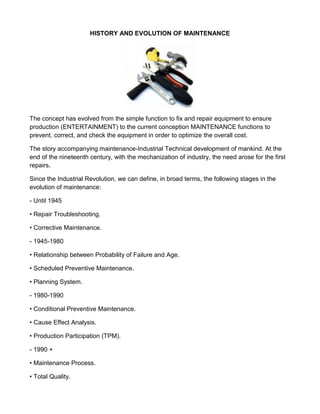Report
Share

Recommended
Recommended
More Related Content
Similar to 2 trabajo omar ortiz 5 b
Similar to 2 trabajo omar ortiz 5 b (20)
International Journal of Engineering Research and Development (IJERD)

International Journal of Engineering Research and Development (IJERD)
Impact of total productive maintenance methodology on the performance

Impact of total productive maintenance methodology on the performance
IRJET- Investigation of Maintenance and Cost Control for High Rise Building

IRJET- Investigation of Maintenance and Cost Control for High Rise Building
2 trabajo omar ortiz 5 b
- 1. HISTORY AND EVOLUTION OF MAINTENANCE The concept has evolved from the simple function to fix and repair equipment to ensure production (ENTERTAINMENT) to the current conception MAINTENANCE functions to prevent, correct, and check the equipment in order to optimize the overall cost. The story accompanying maintenance-Industrial Technical development of mankind. At the end of the nineteenth century, with the mechanization of industry, the need arose for the first repairs. Since the Industrial Revolution, we can define, in broad terms, the following stages in the evolution of maintenance: - Until 1945 • Repair Troubleshooting. • Corrective Maintenance. - 1945-1980 • Relationship between Probability of Failure and Age. • Scheduled Preventive Maintenance. • Planning System. - 1980-1990 • Conditional Preventive Maintenance. • Cause Effect Analysis. • Production Participation (TPM). - 1990 + • Maintenance Process. • Total Quality.
- 2. • Source of Income Maintenance. • Commitment of All Departments. • Risk Based Maintenance (RBM). Maintenance Organization The two organizational aspects that affect the structuring of maintenance are: a) Hierarchical Unit. - Apartments dependent on the direction and at the same level as manufacturing. - Integrated in production to facilitate communication, collaboration and combination. b) Centralization / decentralization. - Pyramidal structure, with one head unit for the entire organization. - Existence of various maintenance departments established by production plants or other geographical bases From the analysis of the advantages and disadvantages of each type of organization it follows that the ideal organization "centralization with decentralization Hierarchical Geographic". Questions. What year was applied Corrective Maintenance? A) 1990 B)1945 C) 1980 What are the main functions of maintenance? A)Prevent, correct B)revise, prevent C) repair, revise Which are the two aspects that affect the organizational structure of the maintenance? A) Hierarchical Unit., Centralization / decentralization. B)Total Quality. C) Cause Effect Analysis. What the needs of the first repairs? A) Repair Troubleshooting.B)Corrective Maintenance. C)None Which was the first maintenance history? A) PreventB) CorrectiveC)Scheduled Preventive Maintenance
